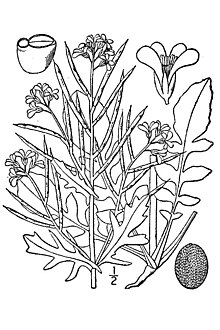Barbarea verna
| Land cress | |
|---|---|
 |
|
| Scientific classification | |
| Kingdom: | Plantae |
| (unranked): | Angiosperms |
| (unranked): | Eudicots |
| (unranked): | Rosids |
| Order: | Brassicales |
| Family: | Brassicaceae |
| Genus: | Barbarea |
| Species: | B. verna |
| Binomial name | |
|
Barbarea verna (Mill.) Asch. |
|
| Synonyms | |
|
|
Land cress (Barbarea verna), also known as American cress, bank cress, black wood cress, Belle Isle cress, Bermuda cress, early yellowrocket,early wintercress, scurvy cress, creasy greens, and upland cress, is a biennial herb in the family Brassicaceae. It is native to southern Europe and western Asia, and naturalized elsewhere It has been cultivated as a leaf vegetable in England since the 17th century. As it requires less water than watercress, it is easier to cultivate.
Land cress is considered a satisfactory substitute for watercress. It can be used in sandwiches, or salads, or cooked like spinach, or used in soup and fish.
Land cress can be grown easily in any garden. Like watercress, it loves water, but does not do well when partially submerged for long periods of time. This perennial needs full sun and frequent watering in any garden, unless near a direct source of water.
Other common names include dryland cress, cassabully, and American watercress. A variegated form is available.
...
Wikipedia
